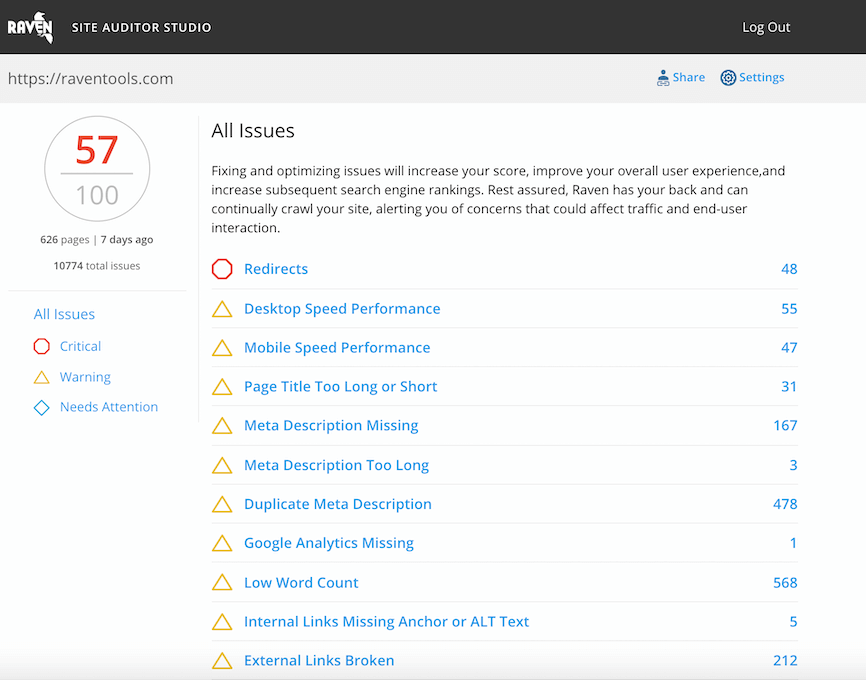While most SEO experts agree that content is an important part of SEO strategy, there seem to be varying definitions for what “great” means, and even mixed ideas about how important highly skilled content writing actually is.
Furthermore, people can have very different strategies for writing “SEO-friendly” content. Some focus on users. Others focus on Google. Some have even gone as far as to say that keywords are what make all the difference in creating content that ranks. But is that really true?
What is SEO Content Writing, anyway?
SEO writing is targeted at search engines and towards specific search queries. You don’t just wax eloquently without doing keyword research and without gathering audience insights. The goal is to drive qualified and targeted traffic.
It may not be all about the exact keywords you’ve used, but the answer is far less complicated than what you may think. In this post, I’m breaking down what matters most for SEO copywriting.
There is no “secret sauce” for writing SEO-friendly content. In fact, SEO copywriters and normal content writers alike can often over-complicate the process and get away from the ultimate goal of the content… which is to help you (or your clients) make money! Despite the lack of secret sauce, you can follow 4 steps to satisfy search engines.
Keep in mind, writing for Google isn’t going to be copywriting that is necessarily optimized for email gen, or for sales, or for getting people to visit other pages of your site.
How to Write Web Copy for SEO: 4-Step Guide
- Use your primary keyword in the page title: This should be fairly simple. If something is important, then the title of your page should include the most important subject (or keyword) to indicate what the page is about.
- Use the most important keywords higher up in the website copy: SEO experiments show a strong correlation with rank and placement of keywords in the body of the blog article.
- Use keyword variations in your article: You don’t write an article with one keyword and expect it to rank. Google wants a host of signals that indicate content relevancy, so including keyword variations is a way to show Google how it should understand your content.
- Study competitors with good on-page SEO content: This is the best way to learn what Google is prioritizing. Look for the type of headers, the number of words, the usage of bold and italics, the number of headers, the images, alt text, video, etc. Add or remove about 15% of the content to vary from whats ranking a bit and BOOM, you’re off to the races.
So what is the key to great SEO content? Well, the key to writing content that WORKS (i.e. sells) is that you have to understand the ins and out of writing for both users and search engines. Doing so is more intuitive than you may think, as long as you understand a few core principles.
Without further ado, here are some rules (or rather — strong suggestions).
1) Identify your exact audience
First and foremost, the effectiveness of your copy depends on how well you know your target audience. I could write a high-quality advanced marketing guide and have a terrible piece of content if my audience was filled with beginner level marketers. Even worse, when a company has sales copy littered about the blog when their audience has either
A) Already bought the product
B) Visited your page for insights but was met with the blog version of a product brochure
Not only will this audience determine KIND of content is needed, but it will also inform the voice of your content, the keywords you decide to focus on, and what your unique selling point (USP) is.
There are many ways to find out what your audience needs and wants, but I always suggest conducting market research before you dive into a piece of content. You can use online surveys, execute on keyword research, do social media polls or connect with some local entrepreneur resources for specific insights.
This way, you will be sure that you are offering your audience something that they are actually searching for and wanting to buy. Without this knowledge, your messaging and/or your keyword research could be off – especially if you are basing your keywords and content off of what your competitors are doing.
You must get inside your ideal client or customer’s head to create copy that will both attract them (through search) and resonate with them (through CRO). Otherwise, your words may fall on deaf ears (or eyeballs, I suppose).
2) Know why you are writing the content — Sounds simple, right?
This may seem like a no-brainer, but experience has shown me that many SEOs overlook this step when optimizing their content. That is, they know that they want “more traffic” for their clients, but fail to dig deeper than that. Not to mention, marketers fail to identify the searcher intent when publishing their blog articles.
If you are doing SEO effectively, you know that organic traffic isn’t everything. Ultimately you want your clients to get a good return on investment (ROI), and that means money. So, the purpose of your article will usually go beyond just generating traffic.
Don’t confuse traffic with conversions or you’ll wind up out of a job.
Conversions can take on many forms. Your goal may be to convert subscribers, drive phone calls, sell products or a host of other objectives but your intentions for your content should always shape your approach. Keep your eye on the prize. Write content that is best suited for what you are trying to achieve, rather than focusing on simply pleasing the Google gods.
Google has a formula for ranking, but ultimately, highly competitive areas require masterful SEO copywriting skills if you hope to generate link worthy content or just content that people want to read.
3) Content writing for SEO relies on studying the data
Once you have a solid understanding of what your audience is looking for and needs, it is time to support your strategy with data. It is not enough to ASSUME that you know what keywords will best apply to your content… you have to provide data that supports your claim.
This is where your keyword research comes into play. If you have been doing SEO for some time, you likely already have this process down to a T. Either way, you will want to see data that:
- Proves that users are searching for your primary keywords
- Covers the competition of those terms
- Shows that the search volume for said terms justifies your strategy
This ensures that you aren’t going into your content process blindly, or wasting time writing content that no one is searching for.
4) Create a content plan
Creating a plan is not an essential part of every search engine optimizers SOP (standard operating procedure), but it is a step that I find to be highly beneficial when it comes to getting organized and setting the intention of the content, not to mention how much it helps a content manager when working with various content writers.
Planning can take many forms. You may decide to write an outline of the content before you write it, create a document that includes your focus keywords, or simply create a calendar for your blog posts. All serve the purpose of making sure that your content is focused, concise, and fits into the framework of your existing site.
Having a content plan can be particularly helpful if you are writing a lot (say, for an entire website) and need to map out the keywords for each piece. You can also add details such as the page titles you are going to use, the meta descriptions, and internal linking. Having this data in front of you will help set you up for SEO success.
5) Know on-page SEO best practices
When it finally comes to “optimizing” your content, in most cases, you would do well to simply follow best practices for on-page SEO. If your site as a whole is already optimized, there is not much more to do to your page or post to bump up the SEO factor.
Surely, if you are highly skilled in SEO, you will already have a process for optimizing your content and may use advanced methods. However, your content can still generate traffic for you if you have the SEO basics (like page title, H2s, meta description, internal linking, image alt text, etc.) covered. Raven Tools has even conducted a study that compiles a list from 4 billion on-page mistakes if you really want to make sure you’re avoiding common errors.
It’s important to not overthink this step and remember that your ultimate goal is to drive conversions. That means writing first and foremost for users and then optimizing for search engines.
6) Test the SEO content – See what works and what doesn’t!
The final step to creating the best content for your audience and goals is to test it! We all know that a plethora of ranking factors exist, and no one can be completely sure whether an article will provide the best user experience for readers. Testing is the final step to on-page optimization.
This is often considered to be an extra step, but A/B testing your content can help you determine the direction you are going to take with future content. You can learn a wealth of information about what works and what doesn’t – and then know what to fix in order to help you get more traffic and conversions. For example, you may find that posts of a certain length work better than others, or that your audience prefers intriguing titles rather than informative ones.
Just know that the success of your SEO content is not a hard science.
Trends change, your follower base may evolve, and Google’s pesky algorithm may even make a shift. In the end, meeting your audience’s needs is what matters most if you’re really wanting the right traffic coming to your site.
Do that, and you will be a happy site in the eyes of Google and your potential customers.
Got questions? Leave a comment or hit us up on social media

Analyze over 20 different technical SEO issues and create to-do lists for your team while sending error reports to your client.








